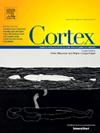变相的可抓性:在处理代表小物体和大物体的词语时的认知和神经差异
IF 3.3
2区 心理学
Q1 BEHAVIORAL SCIENCES
引用次数: 0
摘要
大小是物理世界的基本视觉空间特征。先前的研究已经揭示了大脑对图片所代表的大小物体的不同反应,这意味着物体的大小是组织具体概念的关键维度。然而,反映基于尺寸的分类的大脑反应是否会扩展到像单词这样的符号输入,这仍然是未知的。此外,一些行为研究表明,代表大物体的词(大词)比代表小物体的词(小词)更快地做出词汇决定。然而,这一行为发现与处理小字和大字的潜在神经差异以及潜在的认知过程之间的关系尚不清楚。因此,本研究探讨了小字和大字加工的认知和神经差异。采用词汇决策任务(LDT)和语义决策任务(SDT)对小词和大词的行为和神经反应(EEG)进行了比较。结果表明,在LDT中,被试对大词的反应时间明显短于被试对小词的反应时间,这表明被试对大词具有潜在的加工优势。相比之下,在SDT中没有观察到行为差异。我们的脑电图解码结果显示,在两个任务中,在190-250毫秒时,大脑对小词和大词的反应是明显的,而在390-520毫秒时,只有在SDT中才有明显的神经反应。重要的是,回归表征相似性分析(RSA)表明,这些不同的大脑反应可以用大小单词表示的物体可抓取性来解释,而不是物体的大小。这些发现说明了小词和大词加工的认知和神经差异,确定了可理解性是关键的影响维度,并展示了语义概念的灵活的两阶段加工。此外,我们提出了一个新的假设来解释大词相对于小词的潜在加工优势。本文章由计算机程序翻译,如有差异,请以英文原文为准。
Graspability in disguise: The cognitive and neural differences in processing words representing small and big objects
Size is a fundamental visual-spatial characteristic of the physical world. Previous studies have revealed distinct brain responses to small and big objects represented by pictures, implying that object size is a key dimension in organizing concrete concepts. However, it remains unknown whether the brain responses reflecting size-based categorization extend to symbolic input like words. Furthermore, several behavioral studies have indicated faster lexical decisions for words representing big objects (big words) than those representing small objects (small words). However, how this behavioral finding relates to potential neural differences in processing small and big words, as well as the underlying cognitive processes, remains unclear. Therefore, the present study investigates the cognitive and neural differences in processing small and big words. We compared the behavioral and neural responses (EEG) to small and big words using a lexical decision task (LDT) and a semantic decision task (SDT). Our results showed that in the LDT, reaction times to big words were significantly shorter than those to small words in the by-participant but not by-item analysis, suggesting a potential rather than robust processing advantage for big words. By contrast, no behavioral differences were observed in the SDT. Our EEG decoding results revealed distinct brain responses to small and big words at 190–250 msec in both tasks, with additional distinct neural responses at 390–520 msec only in the SDT. Importantly, the regression representational similarity analysis (RSA) suggested that these distinct brain responses could be explained by object graspability represented by small and big words, rather than object size. These findings illustrate the cognitive and neural differences in processing small and big words, identify graspability as the key influencing dimension, and demonstrate flexible, two-stage processing of semantic concepts. Moreover, we propose a novel hypothesis to explain the potential processing advantage for big words over small words.
求助全文
通过发布文献求助,成功后即可免费获取论文全文。
去求助
来源期刊

Cortex
医学-行为科学
CiteScore
7.00
自引率
5.60%
发文量
250
审稿时长
74 days
期刊介绍:
CORTEX is an international journal devoted to the study of cognition and of the relationship between the nervous system and mental processes, particularly as these are reflected in the behaviour of patients with acquired brain lesions, normal volunteers, children with typical and atypical development, and in the activation of brain regions and systems as recorded by functional neuroimaging techniques. It was founded in 1964 by Ennio De Renzi.
 求助内容:
求助内容: 应助结果提醒方式:
应助结果提醒方式:


